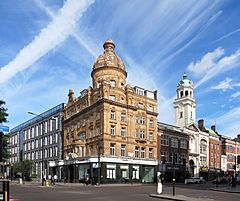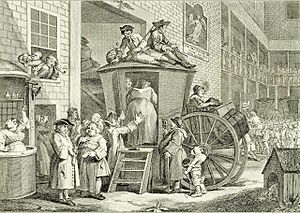The Angel, Islington facts for kids
Quick facts for kids The Angel, Islington |
|
|---|---|

The 1903 Angel Hotel (now offices) on the original corner site with the current pub to the right
|
|
| Former names |
|
| General information | |
| Location | Angel, London Borough of Islington, Greater London |
| Address | 1 Islington High Street |
| Country | England |
| Coordinates | 51°31′55″N 0°06′22″W / 51.532°N 0.106°W |
| Current tenants |
|
| Completed | 1903 (current premises) |
| Renovated | 1979–1982 |
| Owner | Hamilton Investment Properties |
| Technical details | |
| Floor count | 6 |
| Floor area | 1,083 square metres (11,660 sq ft) |
| Design and construction | |
| Architect | Eedle and Meyers |
| Renovating team | |
| Architect | Elsom Pack & Roberts |
| Renovating firm | McLaughlin & Harvey Ltd |
|
Listed Building – Grade II
|
|
| Official name: The Angel | |
| Designated: | 31 January 1991 |
| Reference #: | 1207594 |
The Angel, Islington is a famous building in London, England. It stands at a busy corner in the Angel area of Islington. This spot has been important for hundreds of years.
The land first belonged to a religious group called the Clerkenwell Priory. Buildings have been here since the 1500s. By 1614, an inn on the site was known as the "Angel Inn." This inn gave its name to the whole area. The current building was finished in 1903. It was called the Angel Hotel.
In 1935, the Angel Hotel was even chosen for the British version of the game Monopoly. Today, the building is used for offices. It is a special "Grade II listed building," meaning it's protected for its history. The Angel also gave its name to the nearby Angel tube station, which opened in 1901.
Contents
History of The Angel Building
Early Days of the Inn
In the early 1500s, a building stood here on a main road called the Great North Road. It was first known as the Sheepcote. By 1614, it became an inn called the Angel. The inn got its name from a sign showing the Angel of the Annunciation.
The Angel Inn was a good place to stop outside the City of London. The area outside the city was considered unsafe. Travelers often had armed guards when going to Islington. Even though it's linked to Islington, the inn's land was actually in nearby Clerkenwell.
The Angel in the 1600s and 1700s

By 1630, William Riplingham owned the inn. He added more buildings around 1638. These parts of the inn lasted until the early 1800s. Later, in 1677, James Compton, 3rd Earl of Northampton owned the Angel. Edward Fawcett managed the inn for many years. It was a place for animal traders going to Smithfield Market. It also welcomed people traveling long distances.
In the early 1700s, the Angel was the biggest coaching inn on Islington High Street. A coaching inn was a place where horse-drawn coaches would stop. They would change horses and travelers could rest. The artist William Hogarth drew the inn in 1747. His drawing, The Stage-Coach, Or The Country Inn Yard, showed a busy scene.
In 1756, a new road called the New Road was built. This road cut through the Angel Inn's land. The inn was on one side, and its stables were on the other. The Angel became even more popular because of the new road. It offered rooms for public meetings. It is believed that writer Thomas Paine started writing his famous book Rights of Man here in 1790. A monument on Islington High Street remembers this.
The Angel in the 1800s
By the early 1800s, the land around the Angel was becoming more built up. The Angel Inn was rebuilt in 1819 and 1820. It became a post house and a meeting spot for businesses. It was advertised as the "Angel Inn Tavern and Hotel for Gentlemen and Families."
By the 1850s, the inn was not doing as well. The New Road was renamed Pentonville Road in 1857. Around 1870, shops were added to the front of the inn. The building was also updated inside in 1880. In 1896, a brewing company called Truman, Hanbury, Buxton & Co. bought the main building.
Work on a new building started in 1899. It was designed by architects Frederick James Eedle and Sydney Herbert Meyers. The new building was made of light-colored stone. It had a round dome on the corner. The brewers said it was "the widest-known hostelry in the world." The new building was finished in 1903. A date panel on a balcony still shows this year.
The Angel in the 1900s and 2000s
The inn stopped being a pub in 1921. A restaurant company called J. Lyons and Co. bought the building. They turned it into a large restaurant. It could serve up to 300 people. These kinds of restaurants were popular in the 1920s and 30s. But they became less popular when fast food started in the 1950s.
In 1959, The Angel was closed. The London County Council bought it. They planned to knock it down to build a new road. The building was used for a short time by City University. But people protested against the demolition plans. Groups like "Homes before Roads" helped save the building.
The building was sold again. It was renovated between 1979 and 1982. It was turned into offices and renamed Angel Corner House. For a long time, a branch of The Co-operative Bank was on the ground floor. Today, the building is privately owned. It is still used for offices.
The Angel building is part of a special "conservation area" since 1981. This means its historic look should be protected. The Corner House has been a listed building since 1991. It is a "Grade II" listed building on the National Heritage List for England. This means it is very important historically. New buildings nearby cannot be taller than the dome on the Angel Corner House.
Other Buildings Named Angel
On October 27, 1998, a new pub called The Angel opened. It is run by the pub chain J D Wetherspoon. This pub is next to the old Angel building. It stands on part of the original Angel Inn's land. This land was redeveloped into shops in 1820. The pub was later sold and renamed The Junction.
There is also a hotel called the Hilton London Angel Islington Hotel. It is named after the famous pub. This hotel is located on Upper Street, north of the original Angel building.




